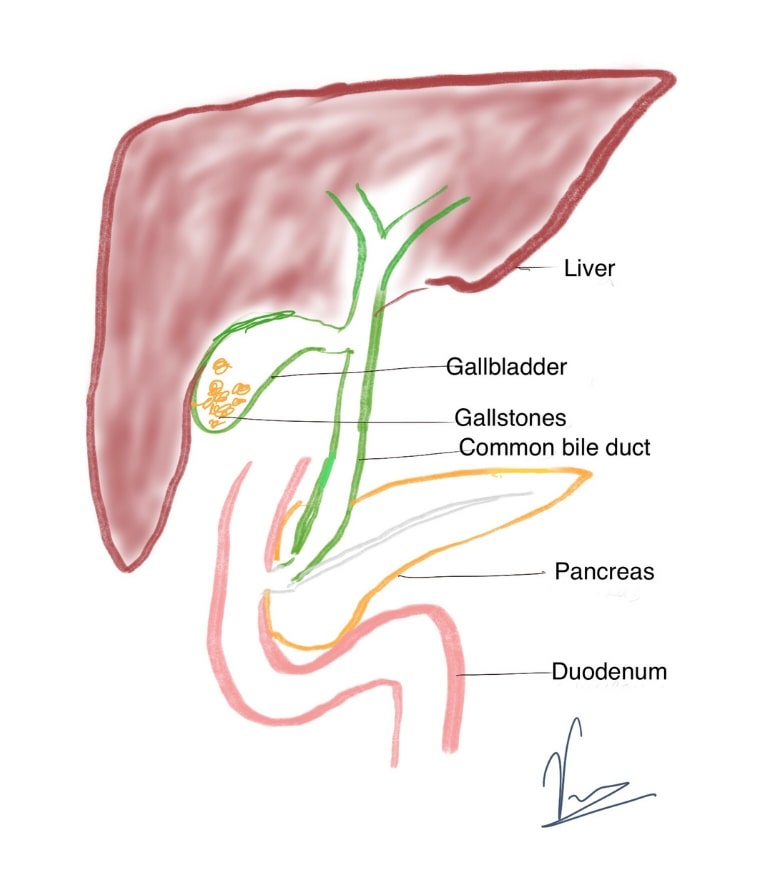
“Can’t I just take some tablets for this? Do I need surgery?”
“I don’t want to undergo surgery. I’m scared that the surgery will be more dangerous than the disease.”
“If this happened because my diet is unhealthy, can’t I just fix my diet and take care of this?”
These are some of the questions we hear often at our center while disclosing a diagnosis of gallstones. Most patients are reluctant to undergo surgery, a very understandable and valid response to the situation. You might even have stumbled upon this page because you’ve recently been diagnosed with gallstones and have been advised surgery. This article is for you to understand a little bit more about what is happening in your body and what the standard medical practice towards the same is. Dr Rengan is an experienced laparoscopic Surgeon who has been performing laparoscopic gallbladder surgery for the past 30 years.
First of all, let’s try and understand what gallstones are and how they cause problems.
Gallstones are some solidifications that form in your gallbladder. Most often, these stones form after a long period of abnormal proportions of gallbladder contents. Many reasons exist for this; including long-standing infection, fatty and carbohydrate rich diet, obesity, estrogen levels (like in pregnancy), abnormal biliary tract structure etc,. Broadly; gallstones can be classified into cholesterol stones, bilirubin stones, and mixed stones based on their composition.
What happens after these stones form?
Most small stones, if few in number, don’t cause any pain or problems. Most people might not even know that they have them. At this stage, they might only be picked up on a routine medical exam or on medical imaging for some other issue. This is when aggressive diet/lifestyle changes and medications can help resolve the condition. Despite this, recurrence is common once the medicines are stopped.
As the stones grow bigger and more in number, more issues start presenting themselves. Gallstones can form anywhere along the biliary tract, and the stones that form in the gallbladder itself are capable of moving into the branches of these tracts as well. In the following image, you can see that the biliary tract connects to 3 main organs from the gallbladder – the liver (from where it receives bile), the duodenum (to where it secretes bile)
and the pancreas (which uses the same duct system as the gallbladder to send its secretions to the duodenum).
Depending on the location of the gallstones, different problems can arise:
In the gallbladder itself (Cholelithiasis)
Gallstones can cause inflammation of the gallbladder (cholecystitis). This causes pain that lasts for a short while but recurs periodically (chronic cholecystitis); or sudden severe pain accompanied by fever, nausea and vomiting (acute cholecystitis). Pain is usually at the right upper abdomen but can spread to the back, shoulder or entire abdomen.
Even in mild cases, the symptoms might be worsened after meals or drinking alcohol. It can be accompanied by bloating and uneasiness. The stones can dislodge and move elsewhere as well. Chronic gallstones in the gallbladder may lead to cancer of the gallbladder (0.1% cases). If the gallstones erode through the wall of the gallbladder from constant inflammation or irritation, it can abnormally join the duodenum (cholecystoenteric fistula) and lead to small bowel blockage, an emergency condition.
In the common bile duct (Choledocholithiasis):
Gallstones can obstruct the bile duct and lead to a severe inflammation of the bile duct (cholangitis). This is characterised by fever, jaundice and abdominal pain. This can sometimes rapidly evolve to cause septic shock ( a dangerous condition in which organ systems of the body start shutting down one by one if untreated) and mental confusion. In the elderly, sometimes no warning signs might be seen and they might just collapse suddenly.
In the junction of the common bile duct and pancreatic duct:
In this situation, the secretions from the pancreas get obstructed and the pancreas get inflamed (pancreatitis). Here, the abdominal pain is present in the central upper/left abdomen and can spread to the back. Sometimes, the patient’s condition can rapidly go down if the pancreas, which has a good blood supply, starts to bleed. The pain is often accompanied by nausea, vomiting, fever and jaundice. Chronic inflammation of the pancreas can lead to diabetes or rarely, cancer of the pancreas.
As you can see, all these complications with the high potential of turning worse has piqued doctors’ curiosity on treating it efficiently and swiftly. So far, the best option that has been seen is surgery. Surgical treatment involves removing the gallbladder itself which ensures that the condition will not turn long-term or recur.
Gallbladder removal surgery:
In fact, Gallbladder removal surgery has high success rates when compared to the potential untreated complications. Over the last couple years, the standard for management of even pregnant patients with symptomatic gallstones has slowly been turning towards laparoscopic cholecystectomy, a.k.a, keyhole gallbladder removal surgery. If you have stones in your common bile duct or pancreatic duct, you will need an endoscopic procedure called ERCP. This is followed by laparoscopic cholecystectomy.
Keyhole surgery is the preferred surgical method these days because of the quick recovery period and low complications. Most patients remark on the immediate relief from pain they experience after the surgery, not to mention, the long term relief from the queasiness associated with gallstones. Dr Rengan will advise you on the right way to go about things.
We will consider postponing surgery or alternative options in patients who are considered high-risk for surgery (eg. very old, many other diseases, poor heart conditions, etc). However, remember that the overall mortality rate from laparoscopic cholecystectomy has been shown to be as low as 0.06% in a broad population. As such, all studies at present point towards surgery as being the best option for the treatment of symptomatic gallstones.
Dr. Rengan is a senior and top laparoscopic surgeon in Chennai who has been performing laparoscopic gallbladder surgeries for the past 30 years.



